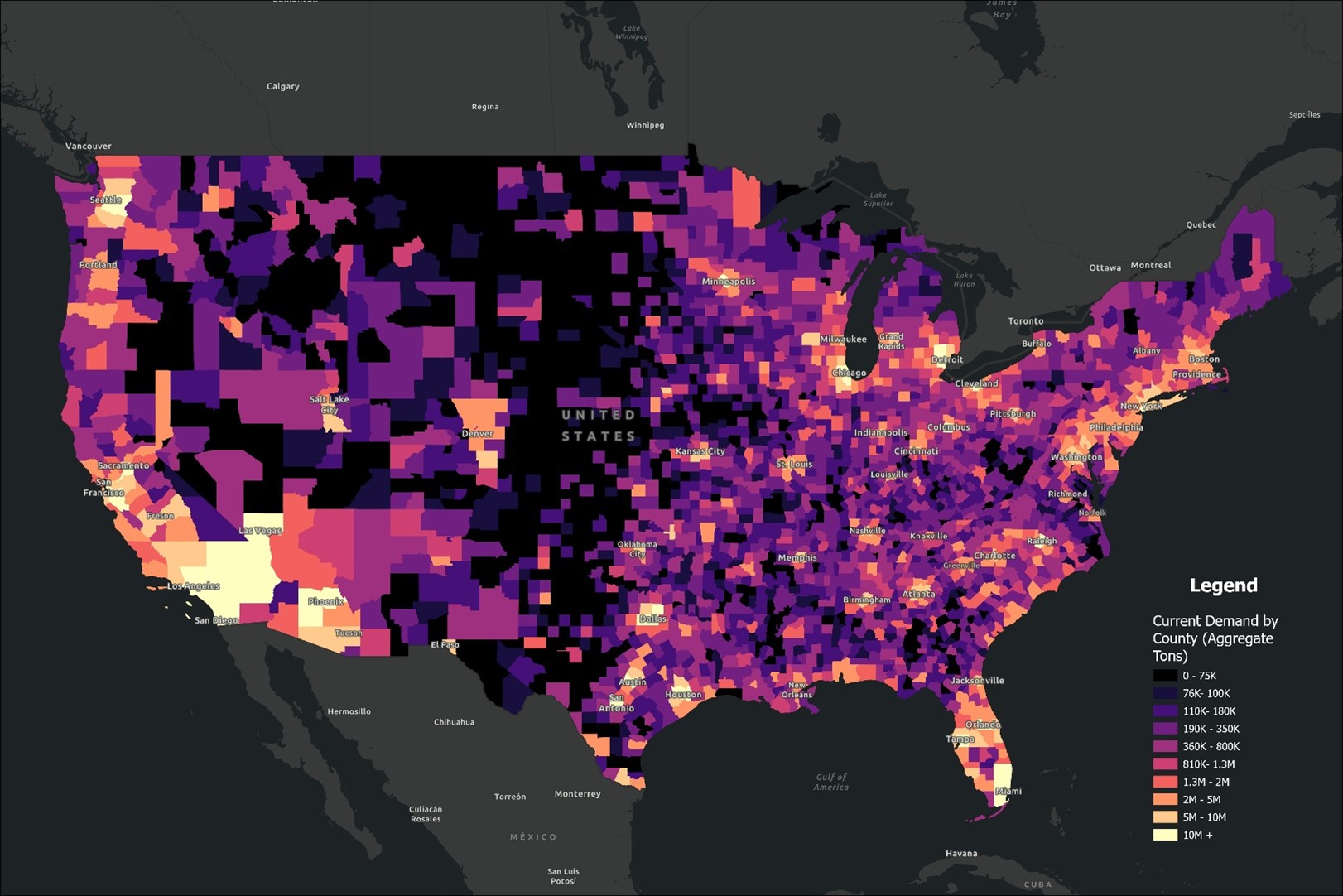Explore the top 25 U.S. counties by estimated aggregate demand in 2024. Learn how construction trends, infrastructure investments, and population growth are driving demand for aggregates across key regions.
Contact Us Today
Contact Us Today
Explore the top 25 U.S. counties by estimated aggregate demand in 2024. Learn how construction trends, infrastructure investments, and population growth are driving demand for aggregates across key regions.
In the ever-evolving landscape of the construction aggregate industry, one constant remains: the need to predict supply and demand accurately. Businesses that can forecast effectively find themselves better positioned in their markets and more prepared for future challenges. In this article, we delve into the rudiments of supply and demand in construction aggregates and how you can forecast future needs. We also introduce a groundbreaking tool, Mineralocity Aggregates, that can transform the way you look at market data.
The principles of supply and demand are universal, and in the aggregate industry, these factors can be influenced by a myriad of variables. However, a fundamental way to gauge market demand is by looking at the population within a defined radius of your operation—generally, 40 to 60 miles—and multiplying it by the regional per-capita annual construction aggregate consumption number. According to the National Stone, Sand & Gravel Association (NSSGA), the average stands at about 7-10 tons per capita. This number can vary significantly from year to year, so it is important to use a long term average.
To establish the supply and demand balance, you take the estimated supply in a specific region and subtract the demand. The resulting number will indicate whether you are dealing with a surplus or a deficit.
Estimating future demand is not a shot in the dark but a calculated extrapolation based on available data. One crucial element is population growth. By utilizing figures from sources such as the U.S. Census Bureau, it’s possible to estimate demand for the next 5, 10, 15, or even 20 years.
What if we told you that there’s a tool that has already calculated future demand for the entire United States, enabling you to compare current and future supply and demand side by side? Enter Mineralocity Aggregates.
With this platform, you can go a step further and quantify the value of future demand in each U.S. county. Leveraging proprietary data provided by Dodge Construction Network, we give you insights into planned but not yet started infrastructure projects that are likely to be aggregate-intensive.
Predicting and understanding market trends is crucial for the longevity of your business. Whether it’s monitoring the pulse of local demographics or keeping an eye on regional infrastructure projects, having the right data and tools at your disposal is a game-changer. Mineralocity Aggregates not only delivers this but also offers a user-friendly interface that makes the entire process efficient and effective.
Understanding the basic dynamics of supply and demand, combined with strategic forecasting, can make all the difference in positioning your aggregate business for long-term success. Mineralocity Aggregates simplifies this complex task, putting comprehensive data and predictive analytics at your fingertips.
Ready to get ahead of the curve? Request a free demonstration today to explore the depth and breadth of our platform’s capabilities.
The construction aggregate industry is foundational to infrastructure and real estate development. For producers, investors, or stakeholders, grasping supply and demand dynamics is paramount. Here’s a detailed yet straightforward guide on calculating aggregate market supply and demand.
At its essence, the concept of supply and demand forms the foundation of economics. They are two fundamental forces that interact to determine the price and quantity of goods in a market.
Supply represents the quantity of aggregates that producers are willing and able to bring to the market at a given price. Various factors influence this willingness, such as the cost of production, technological advancements, and the price of related goods. Simply put, supply is the producer’s side of the story. It answers the question: How much of the aggregate is available for sale at a specific price point?
On the other side of the equation, demand signifies the quantity of aggregates that consumers or businesses desire and are prepared to purchase at a certain price. It is influenced by factors like required specifications, location, end use, and the price of substitute or complementary goods. Demand provides insight into the consumer’s perspective, answering the question: How much of the aggregate do buyers want to purchase at a given price?
The interplay between these two forces, supply, and demand, determines the market equilibrium, where the amount producers are willing to sell matches the amount consumers want to buy. This equilibrium is essential for understanding the pricing and availability of goods in any economy, including the aggregates industry.
Calculating Demand
A deeper understanding of demand necessitates a few key steps:
1. Per-Capita Consumption:
– Use historical data on aggregate consumption.
– Obtain population data, ideally from trusted sources like the [U.S. Census Bureau](https://www.census.gov/).
– Divide the estimated regional aggregate consumption by the population to ascertain annual per-capita averages.
2. Identify the Key Sectors:
– Recognize primary aggregate consumers. This can encompass sectors like housing, road construction, or commercial projects.
3. Forecast Activity & Consumption:
– Source industry reports and growth forecasts to anticipate future sectoral activity, such as the Dodge Construction Network Data that is integrated into Mineralocity Aggregates.
– Multiply expected units (e.g., miles of roads, houses constructed) by the estimated consumption amounts per-unit to estimate aggregate needs.
4. Calculate Total Demand:
– Compile the figures from all sectors to get a comprehensive demand estimate.
Calculating Supply
For a comprehensive supply analysis:
1. MSHA Data:
– Utilize data from the [Mine Safety and Health Administration (MSHA)](https://www.msha.gov/), which provides insights on operational hours for each permitted US producer.
2. Identify Producers:
– Catalog all active aggregate producers in the chosen region.
3. Estimate Production Capacity:
– For each producer, fetch their production potential, often found in annual reports, industry publications, or company websites.
4. Adjust for Constraints:
– Take into account potential restrictions, be it environmental regulations, machinery limits, or labor constraints.
5. Calculate Total Supply:
– Sum up the adjusted capacities of all producers to gauge the total available supply.
Balancing Supply and Demand:
With your supply and demand figures:
– A supply surplus could lead to reduced prices.
– If demand outstrips supply, prices might surge, offering expansion avenues for existing producers or entry points for newcomers.
Deciphering aggregate supply and demand sets the stage for astute decision-making in production, investment, and overarching strategy. While the above method offers a bird’s eye view, the intricate facets of transportation costs, quality diversities, and looming market trends call for meticulous analysis. This is where Mineralocity Aggregates shines, serving as a beacon for stakeholders. Our platform fuses granular data with incisive analysis, crafted through rigorous research, ensuring you not only stay informed but thrive in the industry’s ever-evolving landscape.

Dive deeper into the world of construction aggregate production with our exclusive Greenfield Guide. Whether you’re a seasoned expert or just embarking on your aggregate adventure, this guide is your roadmap to identifying prime locations, assessing supply potential, and capturing significant market shares. Arm yourself with proven strategies, actionable insights, and essential formulas designed to propel your projects to unparalleled success. Don’t miss this chance to elevate your greenfield endeavors – grab your free copy of the Greenfield Guide now!


